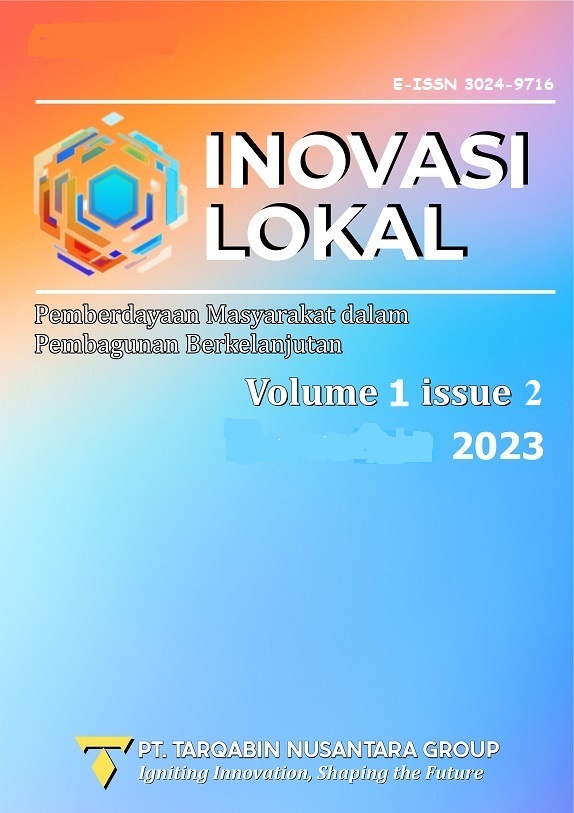Empowering the Independence of Partworld Women in the Use of the DPP Solution Application as a Preventive Measure for Post Partum Blues
DOI:
https://doi.org/10.62255/noval.v1i2.73Abstract
Postpartum blues is a mild postpartum stress syndrome experienced by mothers within 3-10 days. Postpartum blues has symptoms such as excessive sadness, sudden crying, irritability, difficulty sleeping, headaches, and a tendency to blame yourself. Postpartum blues causes mothers to become passive and ignore their babies as well as hormonal imbalances due to anxiety and stress. Mothers experiencing excessive stress have an impact on decreasing interest and interest in babies and the ability to care for their babies properly, not being enthusiastic about breastfeeding so that the health and development of the baby is not optimal. The novelty of this community service activity can provide education regarding the prevention of postpartum depression by using an application. This service activity was attended by posyandu cadres, couples of childbearing age (PUS), pregnant women and postpartum mothers. The purpose of this service activity is to increase public understanding of the prevention of postpartum depression, to be skilled at self-detection and its citizens about postpartum depression. The target of this activity is 30 people. The activity method is carried out twice by giving a pre test, lecture and followed by a post test by filling out a questionnaire. The evaluation was carried out with cadres by conducting interviews on their understanding of prevention of postpartum depression. The results achieved in this activity are that the community gains knowledge about postpartum depression.
Downloads
Keywords:
post partum, post partum blues, anxietyReferences
Afiyanti, Y. 2002. Negotiating Motherhood : The Difficulties and Challenges of Rural First-Time Mothers in Parung, West Java. Makara Kesehatan University of Indonesia, Vol.6 No.2 : 29-34
Ambarwati ER, Wulandari Diah. 2010. Asuhan Kebidanan Nifas. Yogyakarta : Nuha Medika.
Bloch M, Rotenberg N, Koren D, Klein E. 2005. Risk Factors Associated With the Developmentof Postpartum Mood Disorder . Journal of Affective Disorders ; 88:9-18
Bobak, Laudermilk, Jensen, et all. 2005. Buku Ajar Keperawatan
Maternitas. Jakarta : EGC Azwar, S.,2007, Sikap Manusia Teori dan Pengukurannya, Edisi 2, Pustaka Belajar, Yogyakarta.
Alligood, M. R. & Tomey, A. M.,2006, Nursing Theorists and Their Work. 6th. ed, Mosby Missouri.
Alligood, M. R. & Tomey, A. M.,2017, Pakar Teori Keperawatan dan Karya Mereka, Edisi Indonesia Ke-8 Volume 2, Elsevier, Singapura.
Benjamin, J.S. 1994, Buku Saku: Psikiatrik Klinik, Jakarta: Binarupa Aksara. Alih bahasa Japaries W, 1994, Buku Saku: Psikiatrik Klinik, Jakarta: Binarupa Aksara.
Bobak, Lowdermil, Jensen 2005, Buku Ajar Keperawatan Maternitas, Jakarta: EGC. Penerjemah Wijayarini A, 2005, Buku Ajar Keperawatan Maternitas, Edisi 4, Jakarta:EGC
Fatimah, Siti. (2009).Hubungan Dukungan Suami Dengan Kejadian Postpartum Blues Pada Ibu Primipara Di Ruang Bugenvile Rsud Tugurejo Semarang. Ejournal.Undip.ac.id
Gutira, Tia. (2011). Hubungan antara Dukungan Keluarga dengan Kejadian Baby Blues Syndrom pada Ibu Post Sectio Caesaria. Eprint.ums.ac.id.
Irawati, Dian. (2010). Pengaruh Faktor Psikososial Terhadap Terjadinya Post Partum Blues Pada Ibu Nifas (Studi Di Ruang Nifas Rsud R.A Bosoeni Mojokerto). Dppm.uii.ac.id.
Kasman. (2013). Hubungan Tingkat Pengetahuan Ibu Nifas tentang Post Partum Blues dengan Kejadian Post Partum Blues.ejurnalp2m.poltekkesmajapahit.ac.id
Na’im, Nur, Jannatun, 2010. Hubungan Dukungan Keluarga dengan Tingkat Kecemasan Ibu Primipara Menghadapi Persalinan di Puskesmas Pamulang Kota Tangerang Selatan. Jakarta: Universitas Islam Negeri Syarif Hidayatullah.Yogyakarta:DIVA Press (Anggota IKAPI).
Nichols, M.R., Roux, G.M., & Harris, N.R. (2007). Primigravid and Multigravida Women: Prenatal Perspectives, The Journal of Perinatal Education, 16(2), 21-32.
Pfuhlmann, B., Stoeber, G., & Beckmann,H. (2002). Postpartum Psychoses: Prognosis, Risk Factors, and Treatment, Curr Psychiatric, 64,1284-1292.
Pieter, H.Z. & Lubis, N.L. (2010). Pengan-tar Psikologi untuk Kebidanan,Jakarta: Kencana.
Pilliteri. (2003). Maternal and Child Health Nursing: Care of Childbearing and Childrearing Family, 3rdedition,Lippincott.
Rahmandani, A., Karyono, & Dewi, E. K. 2008. Strategi Penanggulangan Coping pada Ibu yang Mengalami Postpartum Blues di RSU Daerah Kota Semarang.Journal Psikologi
Rahmawati, dkk. 2009. Perawatan Masa Nifas. Cetakan ke-3. Yogyakarta: Fitramaya.
Rusli, R. A., Meiyuntariningsih, T., & Warni, W. E. 2011. Perbedaan Depresi Pasca Melahirkan pada Ibu Primipara Ditinjau dari Usia Ibu Hamil. Jurnal INSAN. Vol 13, No 01: 21-31.
Urbayatun, S. 2010. Dukungan Sosial dan Kecenderungan Depresi Postpartum pada Ibu Primipara di Derah Gempa Bantul. Humanitas, Vol.VII No.2: 114-122
Stuart dan Sundden. (2002). Buku Saku Keperawatan Jiwa, Jakarta: EGC.
Widyastuti Y. 2009, Kesehatan Reproduksi, Yogyakarta: Fitramaya.
Downloads
Published
How to Cite
Issue
Section
License
Copyright (c) 2023 Fitriana Solikhah, Maria Diah Ciptaning Tyas

This work is licensed under a Creative Commons Attribution-ShareAlike 4.0 International License.












